Introduction
While a familiar web site destination, blogs also have a role to play within an organisation, especially for cases where a more one-to-many communication style is appropriate. Jiglu’s blogs have all the features you would expect a blogging system to have, including moderated comments, scheduling of posts and email newsletters.
Blogs are just one kind of group in Jiglu. There are also spaces (which may be better for many-to-many communication) and monitors (for working with and analysing different kinds of external content).
Joining a blog
There are two main ways you can join a blog:
- You can find public blogs in the directory of blogs and then ask to join. The directory is available by selecting Blogs on the system-level navigation bar. You can then select the link to a blog to view its home page. Some blogs in the directory may be open for anyone to read, for others you may need to be a member before you can read the content. You can join a public blog using the form on its home page or by selecting the user menu at the top right of each page and choosing the Join blog
- You can get an invitation from an administrator or possibly a member of an existing blog. When a blog is private and not shown in the blog directory this will be the only option you have for joining it. The invitation will be sent by email with a link you can click to join the blog. If you go to My tasks you will also find a task that you can action to take the next step in the joining process.
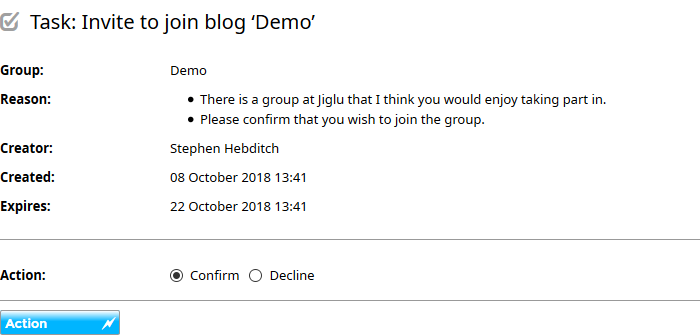
Once you ask to join a blog you may still need approval from a group administrator before the membership process is completed. You will receive an email welcoming you to the blog once this is done.
If you later want to leave a blog you can either follow the link in the Membership section on the blog home page or select the user menu at the top right of each page and choose the Leave blog option. You may still need approval from the administrator to leave the blog.
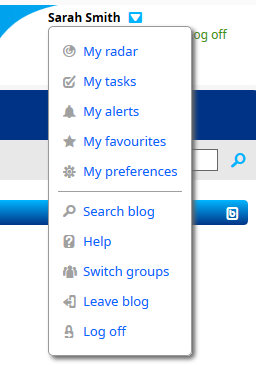
Blog home page
The blog home page is where you will see the most recent posts along with other information about the blog and activities that have taken place. Each blog has its own home page, customised by its administrators for what they think will be useful for members.
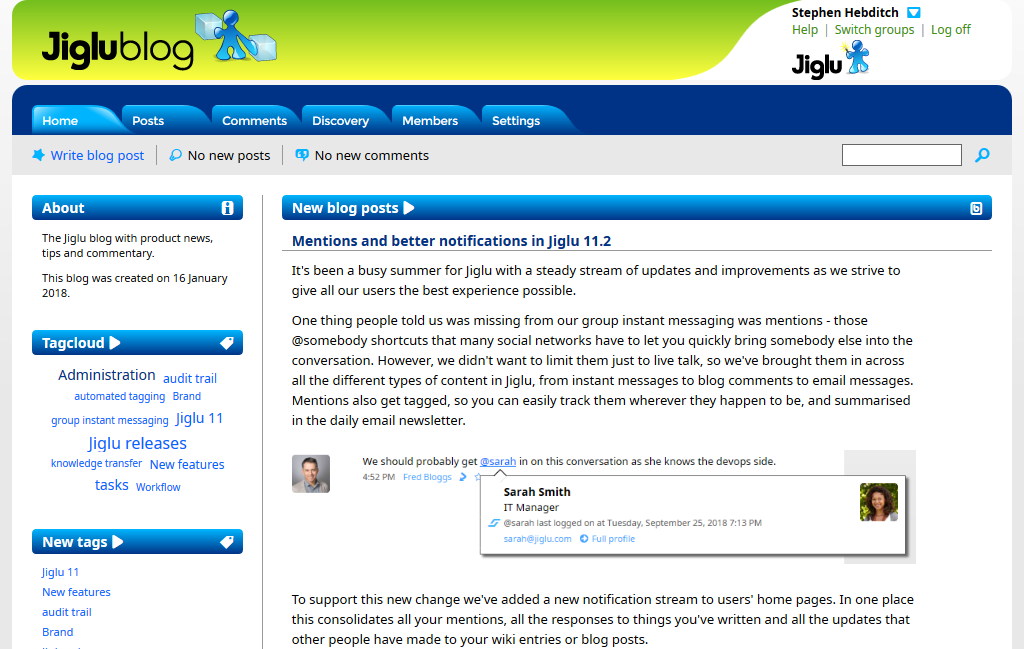
Blog posts can have two text parts. The first will be shown on the blog home page. The second will only be shown if you go to the page for that particular post. Follow the Continue reading link to view the post in full.
The quickest way to get to the home page of a blog that you are a member of is to choose the Switch groups link at the top right of each page and then select the blog that you want.
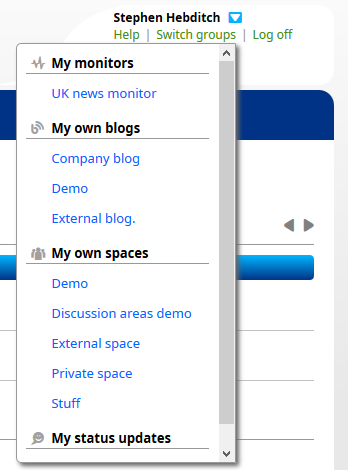
Posts
The posts section is where you can find the full archive of blog posts that have been made. Posts in the index are listed chronologically in the reverse order of when they were first published. You can also search posts for those containing particular words, published in a particular time period or written by a particular user.
Viewing a post
Each post has the same basic format:
- The text of the post. This can include images, videos or content embedded from other websites.
- Any images in the message. A thumbnail is displayed for each image and if there are more than will fit the width of the page then you can scroll left or right using the arrow buttons or your mouse wheel. Selecting an image will open it up on the page.
- The author of the message and, if different, who edited the last published version. If you hover over the author link you will be able to see more information about them and selecting it will take you to their profile.
- Any attachments to the message. If you hover over the link to an attachment then you will be able to see more about the attachment, including its format, size and possibly a text description when this is available. Selecting the link will download the attachment. If there is more than one attachment then there will also be a link to download them all.
- Any links to external websites and inline links to knowledge entries in this blog. Hovering over a link will show a summary of the page that is being linked to, if available.
- Any tags. Selecting a tag will let you see other contributions in the blog with the same tag. Manually-assigned tags will be shown first in bold.
- If you have permission you will be able to view earlier published versions of the post by selecting the Version history
- Any comments in response will be shown after the entry.
Writing a post
If you are the administrator of a blog or have been given permission to write posts then you can start one by choosing the New post link on the view bar on the blog home page or from the posts index choose the New post button or Write a new blog post action in the sidebar.
The editor also lets you include attached images within the text of your message by selecting the Insert / edit image button and may allow you to embed video or other assets from external sites by selecting the Insert / edit embedded site button. Help on using these can be found in the Using Jiglu support space.
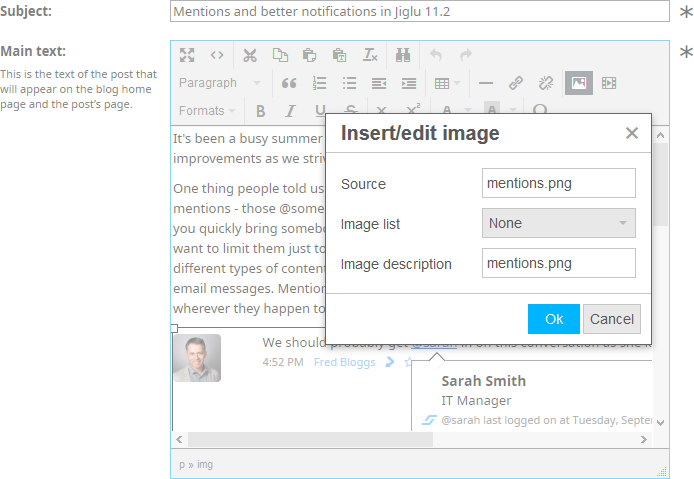
Attachments can easily be added to a message either by selecting the Browse files button and choosing with the file selector or by dragging and dropping files from your desktop onto the page. Note that some file formats may be explicitly disallowed.
You can manually choose tags that you want the post classified under. You can either start entering their names, with the system suggesting similar ones that already exist, or if you select the Pick tags button you can see tags suggested for the post and browse through or search ones that already exist.
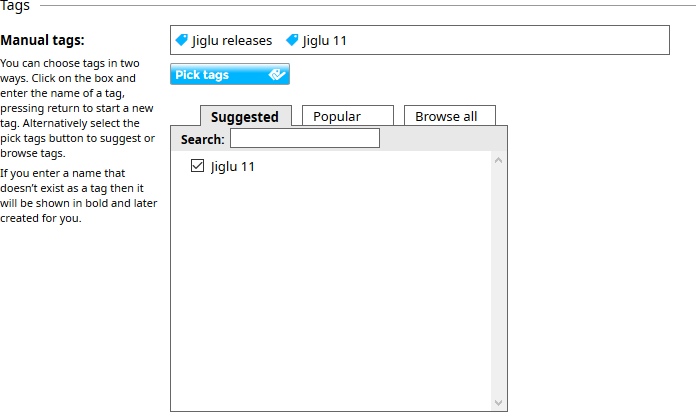
Posts are versioned. Each time you make an edit to a post a new version is created. You can go back to an earlier version if needed by selecting the Revert button and choosing the version you want. If two people start making changes to a post at the same time then the user that submits their post for publication last will be told about this and will need to merge their changes with those of the other post. You can add notes to each version, so other users know what changes were made.
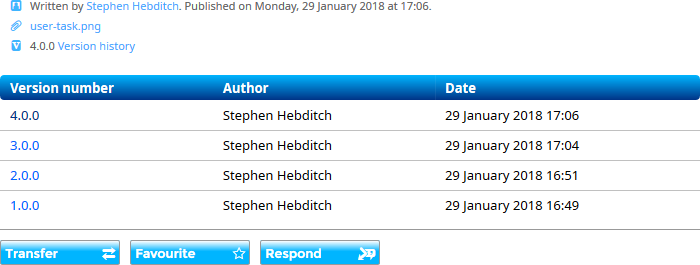
Once you are happy with your post you can see what it will look like when published by selecting the Preview button or submit it for publication by selecting the Publish button. If you want to come back later to finish work on the post then select the Store draft button. You can see all your drafts by selecting the user menu at the top right of each page and then the My tasks option. Note that there may be a limit on how many drafts you are allowed at one time.
Comments
Some blogs may allow members to add their comments to posts. To respond to a post select the Respond button beneath the post. To respond to another comment select the Respond button beneath the comment in question. Note that unlike blog posts, comments cannot have any attachments.
If you want to mention another user in your comment, alerting them to the conversation, then type the ‘@’ symbol followed by their username. As you start typing a popup menu will appear that lets you easily insert the right name.
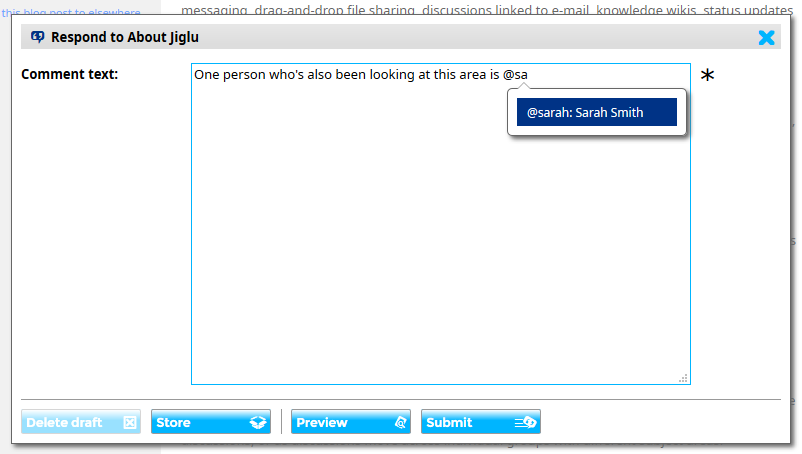
Once you are happy with your comment you can see what it will look like when published by selecting the Preview button or submit it for publication it by selecting the Submit button. If you want to come back later to finish work on the message then select the Store draft button. You can see all your drafts by selecting the user menu at the top right of each page and then the My tasks option. Note that there may be a limit on how many drafts you are allowed at one time. Comments may be subject to approval first, so it may not appear immediately.
Comments are shown beneath each blog post. You can also view comments individually by going to the Comments section. Comments in the index are listed chronologically in the reverse order of when they were published. You can also search comments for those containing particular words, published in a particular time period or written by a particular user.
When a comment is shown, underneath you will be able to see its author, what comment it is a response to, if any, and when it was sent. If you hover over the author link you will be able to see more information about them and selecting it will take you to their profile. If you hover over the parent message you will be able to see information about it and selecting it will take you to the original comment.
Discovery
The discovery section holds information that the system has found by examining the content of posts and comments. It helps you make connections between different pieces of information both within a blog and in other groups.
There are four subsections in Discovery:
- Tags shows you how contributions have been classified, using both tags that members have manually entered and ones automatically generated by Jiglu’s Dynamic Discovery engine from examining the content and metadata of contributions and attachments. More information about tagging is available in the Tagging Quickstart.
- Links shows you all the links that have been mentioned in contributions. This gives you an easy overview to external sources of information that members of the group have found useful. For each link you can see the history of every time it was used.
- Attachments shows you every attachment added to a blog post. Those with the same content or similar names are grouped under the same name, giving you a complete history of where they were used and letting you easily trace different versions of the same document.
- Insight provides content analytics, letting you see visualisations of top and trending tags and the activity taking place in the blog.
Members
The members section is where you’ll find an index of all the members in the blog and their personal profiles giving information about their involvement in the group.
The member index shows basic information about each member, such as their name and username. You can also search for members in a variety of different ways, including their name and when they joined.
Selecting the link for a member will take you to their profile. Information in the profile will include:
- Basic information about the user and their photo, in common with their user profile.
- Details they have entered in their user profile, shown in the global directory of users.
- A summary of their involvement in the group, such as when they joined and how active a participant they are.
- A stream of recent activities that they have carried out in the blog.
If you have permission, the member index may also contain an action letting you invite new members to the blog. You may also find a link to invite a user on the home page of the blog.